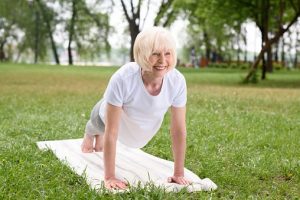

Postmenopausal osteoporosis is a progressive deteriorative condition that affects women who have gone through menopause. Osteoporosis causes the weakening of the bones, resulting in thin and brittle bones that are more susceptible to fractures and breaking. In women who are postmenopausal, osteoporosis is most commonly caused by a lack of estrogen. After a woman has gone through menopause, bone breakdown becomes more aggressive than the building of new bone.
What Are the Symptoms of Postmenopausal Osteoporosis?
It’s often difficult for physicians to diagnose osteoporosis, as bone weakening generally shows no obvious symptoms. The condition can remain undiagnosed for a long period of time, sometimes only being recognized after a fracture or bone injury is suffered as the result of a minor bump or fall.
As the disease progresses, symptoms may begin to appear. These include:
- Becoming shorter, caused by a weakened spine
- More frequent bone fractures. Hip bones are particularly susceptible to fracture in women with postmenopausal osteoporosis.
- Bone pain and tenderness
- Pain in the neck, spine, and lower back
- Broken bones or other bone injuries
- Brittle fingernails
- Loss of teeth
- Low levels of calcium in the blood
- Incontinence
In some cases, spinal deformities will become obvious as the bones in the spine lose their density and strength. These deformities can take the form of a stooped posture or an outward curve in the top of the spine and are often due to the collapse of vertebrae.
Also read: Osteoporosis fractures: Exercises and their benefits in reducing bone fracture risk
Ways to Prevent and Treat Postmenopausal Osteoporosis
Osteoporosis is a condition that can be prevented or postponed by following certain healthy lifestyle habits and behaviors.
- Regular exercise is a part of any healthy lifestyle. For osteoporosis prevention and treatment, focus on weight-bearing exercises that use your body weight against gravity for building and maintaining bone density.
- Proper nutrition is critical for maintaining a healthy lifestyle. Osteoporosis is particularly affected by calcium intake. If you’re unsure if you’re getting the right amount of calcium in your diet, consult your physician or nutritionist. Some studies have shown that following a Mediterranean diet can be beneficial for maintaining bone health into old age.
- Quit smoking if you do smoke and avoid prolonged exposure to secondhand smoke if possible.
- Consume alcohol in limited amounts. Do not drink in excess and avoid alcohol altogether if possible.
- Avoid consumption of sugary drinks such as soda and juices. Stick to water or water-based beverages.
- Make bone density measurement/testing a part of your regular yearly medical checkup. As you get older, this is a crucial way of identifying osteoporosis before it advances to the point where bone density cannot be restored.
Chances are, at some time in our lives, we will all know someone who suffers from osteoporosis. Being aware of the signs, symptoms, and preventive measures we can take against the condition is the best way to decrease its prevalence worldwide.
Also read:
- Can osteoporosis be reversed? 12 natural ways to treat osteoporosis
- Osteoporosis diet plan: Foods to eat and avoid